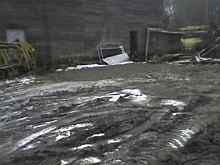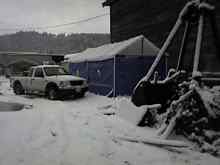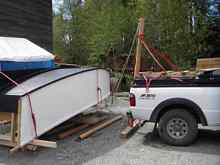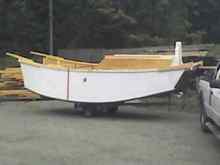
 Custom Search
|
|
| sails |
| plans |
| epoxy |
| rope/line |
| hardware |
| canoe/Kayak |
| sailmaking |
| materials |
| models |
| media |
| tools |
| gear |
 |
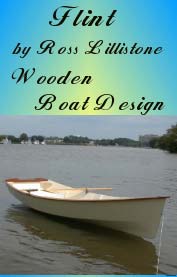 |
| join |
| home |
| indexes |
| classifieds |
| calendar |
| archives |
| about |
| links |
| Join Duckworks Get free newsletter Comment on articles CLICK HERE |
|
|
| Back to Building Part 3: Design Becomes Reality |
by Kevin McNeill - Ladysmith, British Columbia - Canada |
|
Back to the search for a building site. The overall length of the boat would be about 20 feet and my shop, read single car garage, is only 23 feet long by 13 feet wide. It could be done but the tool benches down one side would have to go, the other side could stay but it would be tight and the table saw would have to live outside. Since we live in a strata I would have get this approved by the Strata Council, fat chance of that. I could have build the boat in the driveway but if I didn't stand the proverbial snowball's chance to get the OK to have the saw outside, well maybe not just the saw may be some other things as well, what chance would a 20 foot temporary building stand? Luckily I have a friend who has a small cedar and fir sawmill at the end of the local harbour. He offered to rent me some space to erect what I grandly call the Boat Shed. Actually it's a 10x20 shelter awning, $149 at Canadian Tire, with blue poly tarp sides. I could have done the same thing on my daughter's property but it's a 25 minute drive versus 6 minutes to the sawmill and with the cost of gas up here and the mileage I get on my truck that pays for the rent in no time. Plus there was the very great chance that I would be very handy for occasional baby sitting for the train afficionado, AKA my grandson. Not much work gets done under those conditions.
The picture above shows the location. This is at high tide. At low tide the water's edge is off the bottom of the picture and then some. My friend calls it 50/50 waterfront. In any event I accepted his offer and on 19 Jan 09 started erecting the Boat Shed. Two bucket loads, 10 yards, of gravel later I had a level spot and up went the tent. See, I really do know what it is. One of the great things about working around a sawmill is there is all this lumber, some of it left over from previous endeavours and never used. So the shelter is erected on 12 foot 6x6 between the posts, leveled using my handy laser level, and 16' 2x12's to make up the floor or at least part of it, all of this was scrap would you believe.
I laid out the bulkhead locations using 2x10 left over from a previous project, our new SAR hall. The ground in the left hand picture is frozen solid, you can see the new gravel on top. Five days later it had all melted and became a mud pit. I alternated my time between making bulkheads at home in the shop and putting them up.
Things were going swimmingly, I was working on the boat almost daily and I had planned for a September launch. In March things changed. It snowed and I started a new job, building slowed to a snail's pace. My new job required me to go out of town for training and then to shadow a guy doing the same work. I was then on call 24/7 for 7 days out of 28 and doing paperwork the remainder of the time plus I was still running my business. I did manage to get the sails made during this period. Being a bit of a softy for canvas (and also being cheap, er, frugal) I found painter's drop cloths which are light weight canvas, one 8x12 and one 12 x14. Since the junk sails are bound between battens this would fit the bill admirably. One afternoon to cut the sails out, one evening to sew the mizzen and one afternoon to do the main. Bingo. Then I needed to do some sailor work, sewn eyes and a bit of roping for the mizzen. It's amazing how all the skills you learn as a young seaman (40+ years ago) all come rushing back when you pick up the needle and palm. September came and went. I was so busy that I didn't even take pictures, at least not that I can remember. The rainy season came again and then snow again but in the spring I got back to it. My business had slowed to a crawl and I had some time on my hands. The sides went up, two layers of 4mm verollo, glued together in situ, good side out. Then the
bottom went on, again two layers of 4 mm verollo good side out, sandwiching a layer of 3/8th ply. So 3/8th hull sides, good both sides, and ¾ bottom, also good both sides. So by May I was, as the PD racers say, in 3D, by June the bottom was finished, four coats of rocker panel paint and four coats of 100% acrylic latex exterior house paint, so I was ready to turn it over. Now I weigh in excess of 200lbs and at that stage the hull only weighed just short of 600lbs. So to my tiny mind it seemed simple, rig a gin pole and a three to one block and tackle, 200lbs pull on one end equals 600 on the other and up she would go. Nothing to it, Ha. Here's the gin pole rig,
Slick, isn't it. It worked like a hot damn but only when my friend hitched his forklift to the end of the haul line. Apparently there something about friction that should have been included in the calculations. Here's another view. Actually I was admiring the hull which I'd never seen from any distance before, Boy, it's big.
I did have a plan B. In the picture you can just make out a large tree on the right hand side visible over the cab of the truck. Plan B was to drag the boat over there and then rig the 3 to1 up the tree and use the truck to haul. It would have been a slow process because I would have had to haul five feet, stop the truck, get out, move the rollers then move about five feet further and do it all over again. Luckily I picked a day when my friend was working. The keel piece that you see, not the skeg only the keel, is a 22' fir 2x6, full size not nominal, and there is a 1x4 piece just like it as the keelson. Both pieces were straight as a die and not a knot in them. When you have friends etc. etc. But it was tough putting them through my little planer. The chine logs, inner and outer, the gunnels and stringers were all constructed out of 1x3 fir that had been sitting around for years, remnants of a previous sawmill on this site. My friend had sold most of it as firewood as most of the pieces had rot in them but by picking through the bundles I found enough for my needs and some extra. The other bonus of being here is being able to pick through the off cut pile which is also cut up for firewood, I've managed to rescue many useful pieces this way. Anyway turning her over, see we're now in 3D and it's not a thing any more but a being, was relatively easy thanks to the forklift as was returning her to the Boat Shed, even without the use of the forklift. All those skills I learned long ago turned out to be useful outside of the Navy after all.
I again planned on a September launch. Again building slowed to a crawl, my business picked up a little bit and one of the guys I worked with quit so now I was 10 days on 20 days off but with more paperwork. But the boat did progress. To the point that by mid September the cuddy was closed in, ballast and buoyancy tanks installed and various odd bits, masts, spars, etc made up ready to go. As October approached my friend said he really needed the space to store lumber so it was on to plan B, my daughter's place. I hadn't really thought about a trailer to move the boat except in a vague way so now I started looking for one. Cheap you understand. Nothing to be had on short notice, so I borrowed another friend's trailer to move the boat. He said it was rated to 2000 lbs. He exaggerated. Here's the boat sitting on the trailer ready to go, can you see the trailer? My sawmill friend said it looked like a watermelon sitting on a pea. A little unkind I thought.
Luckily it was perfectly balanced and once I reinflated the tires away we went to Maple Bay and my daughter's place. The RCMP must have had a day off because I had no trouble on the trip. One more trip after that to move the Boat Shed, another day to erect it again and I was set. There are a few difficulties. It's now a fifty plus kilometre round trip and the Boat Shed is a150' from the nearest power source. The other kicker is that I can't get down to work on it during my 10 day oncall period as my daughter's place is outside my oncall area. There also the risk of babysitting to consider but it's free and I can stay there as long as I want. It's only five kilometres to the boat ramp in Maple Bay and a days sail to Ladysmith where I'm putting in a free mooring. I plan on an April launch. He, he , he , he! You may have noticed a strange admixture of weights and measures, pounds, feet and inches in some places and metric in others. Canada is nominally a metric country but being Canada nobody cares what you use, except maybe the government and I'm not sure they've got it straight, so most lumber is in imperial measure but road distances are metric. Some plywood is metric, see the verollo above, but the sign in Home Depot say it's a 4x8 sheet not 1200 mm by 2400 mm. It's like paint, you go to the hardware store and ask for a gallon of paint except it's not a gallon it's actually 3.7 litres, says so on the can, but everybody knows what you mean. Even when I'm working on the boat or other projects I measure in either system depending upon which is easier at the moment because the tape measure has metric on one edge and imperial on the other. The kids think mostly in metric because they're taught that in school but if you say so and so is six feet tall or a soccer goal is eight feet high by eight yards wide they know what you mean. Ain't it grand! Kevin McNeill from beautiful Ladysmith BC. Experience starts when you begin - R. D. Culler |
 |

